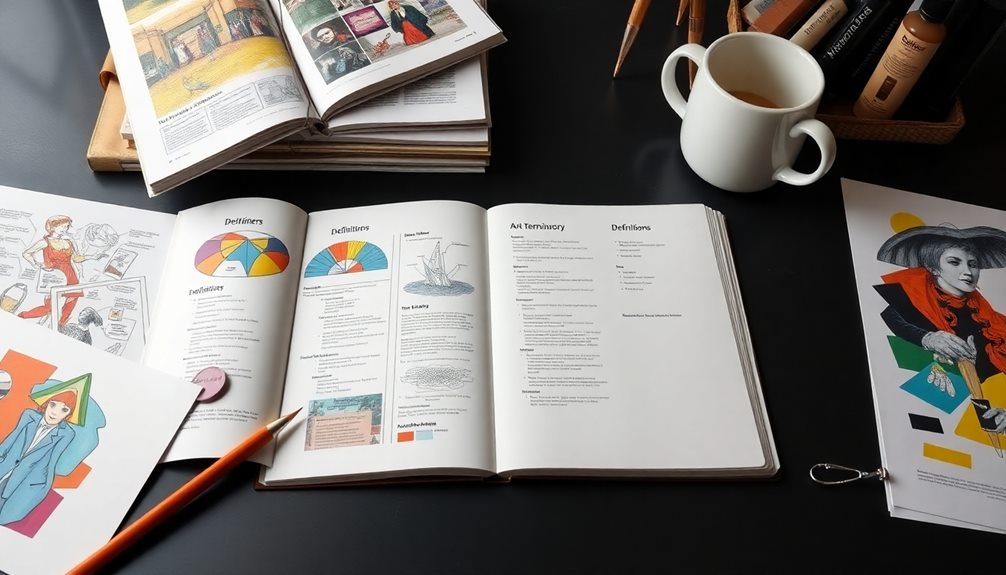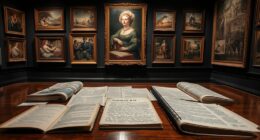An art analysis paper typically starts with a concise introduction, mentioning the artwork's title and artist. Next, you'll explore key concepts and definitions to understand the visual elements. The main body focuses on a thorough analysis of formal aspects like line, color, and texture, situated within historical and cultural contexts. Include your observations and interpretations, balancing objective insights with your personal reflections. Finally, wrap up with a conclusion summarizing key findings and their contemporary relevance. This structure not only clarifies your argument but also invites deeper engagement with the artwork that awaits.
Key Takeaways
- Begin with a concise introduction that includes the artwork title, artist, and significance to set the stage for analysis.
- Focus on formal analysis by examining visual elements like line, color, and texture to provide objective descriptions.
- Contextualize the artwork within historical and cultural frameworks to deepen understanding and enrich the analysis.
- Balance objective insights with subjective interpretations to reflect personal responses while maintaining analytical credibility.
- Conclude by summarizing key findings and reflecting on the contemporary relevance of the artwork to encourage further exploration.
Introduction

The introduction of your art analysis paper should be brief and impactful, typically spanning just 2-3 sentences. Start with the title of the artwork and the artist's name to establish your subject matter immediately. For example, "Starry Night by Vincent van Gogh captivates audiences with its swirling skies and emotive colors." This initial sentence sets the stage for your analysis and showcases the focal point of your paper.
In the second sentence, you can offer context or significance about the artwork or its creator. This isn't mandatory, but it can enhance the reader's understanding. For instance, you might mention how van Gogh painted "Starry Night" during a tumultuous period in his life, which adds depth to your analysis.
Keeping your introduction concise is crucial; avoid lengthy or overly complex statements that can confuse readers. Remember, the introduction shouldn't only present the artwork and artist but also hint at the main argument or focus that will be explored in the following sections.
This clarity and directness will engage your audience and prepare them for your insightful analysis.
Key Concepts and Definitions

Art analysis relies on key concepts and definitions that provide a foundation for understanding the visual elements of a work. To effectively engage with a piece of art, you must grasp the principles of Formal Analysis. This approach allows you to dissect the artwork's components—like line, color, texture, and composition—helping you build a strong thesis statement grounded in visual evidence. By analyzing paintings with formalist theory, you focus solely on the visual aspects of the artwork, setting aside context, historical background, or the artist’s intent. This method emphasizes the importance of observing how the arrangement of elements like shape and balance contribute to the overall impact of the piece. Ultimately, a formalist approach fosters a deeper appreciation of the artwork’s structure and aesthetic harmony.
When analyzing art, it's crucial to focus on objective descriptions rather than subjective opinions. This ensures that your observations connect directly to the broader interpretive themes relevant to the artwork. Each element you discuss should tie back to your thesis, reinforcing your overall argument and enhancing your analysis.
Additionally, clarity and precision are vital in your writing. Avoid vague language and ensure that your definitions are straightforward and relevant. A well-structured analysis not only clarifies the visual aspects of the art but also situates it within its historical and cultural context.
Essential Elements of Analysis

When diving into an art analysis paper, starting with a clear introduction is crucial. You should include the artwork's title and artist, which sets the groundwork for your analysis.
The main body needs to focus on formal analysis, where you examine key elements and principles like line, color, texture, and composition. This examination helps articulate how these elements contribute to the overall effect of the artwork.
Detailed observation is essential; identify dominant visual elements and their relationships within the piece. This scrutiny supports your analysis and enhances clarity.
Additionally, contextualizing the artwork within its historical and cultural framework will deepen your understanding. It provides insights into the artist's intentions and the societal influences that shaped the work.
Real-world Art Analysis Examples

Analyzing artwork isn't just about observing visual elements; it's also about understanding how these elements come together in real-world contexts. For instance, when you examine a painting like Van Gogh's "Starry Night," you can focus on its formal elements, such as the swirling lines and contrasting colors.
In your writing, you'd start with a concise introduction that includes the artwork's title, artist, and its significance.
As you move into the body of your analysis, you'd delve deeper into these formal elements, providing specific examples that illustrate how they contribute to the overall impact of the piece. Incorporating contextual information about Van Gogh's life and the historical backdrop can enrich your analysis but remember to keep the emphasis on visual elements.
In a well-structured conclusion, you'd summarize your key findings, reflecting on the artwork's relevance today. You might even pose a thought-provoking question that invites further exploration.
Real-world examples of art analysis papers highlight the importance of a clear thesis statement and logically organized arguments, seamlessly integrating visual evidence throughout your discussion. This approach not only strengthens your analysis but also engages your readers.
Tips and Best Practices

To kick off your art analysis paper effectively, start with a concise introduction that captures the essence of the artwork. Mention the title, artist, and its significance in just 2-3 sentences. This sets the stage for your analysis and helps the reader understand the context of the work.
Next, organize your analysis logically. Focus on formal elements like line, color, and texture, and ensure each paragraph supports your central thesis with specific visual evidence. Using objective language is crucial; avoid subjective opinions and maintain clarity in your descriptions.
When conducting your Visual Analysis, explore how the elements work together to create meaning. This approach not only enriches your argument but also demonstrates a deeper understanding of art history.
As you wrap up your paper, summarize your key findings and reflect on the artwork's overall impact. Consider its relevance in contemporary contexts to provide a thoughtful conclusion.
Lastly, always proofread your paper for grammatical accuracy and coherence. Seeking feedback from peers or writing centers can enhance the quality of your analysis, ensuring you present a polished and insightful piece.
Audience Engagement and Feedback

Engaging your audience in an art analysis paper is essential for creating a meaningful connection with the artwork. To achieve this, use clear and concise language that effectively communicates visual elements and their significance. Incorporating questions or prompts throughout your analysis can encourage readers to reflect on their interpretations, fostering a deeper connection with the piece.
Utilizing visual evidence to support your claims not only strengthens your argument but also helps the audience visualize the points being discussed. By presenting concrete examples, you make it easier for your readers to understand your perspective.
Additionally, sharing your personal response to the artwork invites your audience to connect on a more emotional level.
Don't underestimate the value of feedback. Seeking input from peers or instructors can refine the clarity and impact of your analysis, leading to a more engaging and insightful final paper.
Addressing potential counterarguments or differing interpretations within your analysis enhances critical thinking and invites diverse perspectives, enriching the discussion.
Balancing Subjective and Objective Insights

Balancing subjective and objective insights can elevate your art analysis, allowing for a richer understanding of the work. In your analysis paper, it's essential to present personal interpretations while grounding them in visual evidence from the artwork made.
Start by describing the work with objective insights, focusing on technical aspects like composition, color, and form. This helps establish a clear foundation for your analysis.
Once you've outlined the objective features, weave in your subjective insights. Reflect on your emotional and intellectual responses to the artwork. Ensure you maintain a clear distinction between what you observe and how it makes you feel. By doing this, you'll support your interpretations with concrete visual evidence, enhancing the credibility of your analysis.
Using formal analysis techniques can help keep your analysis grounded. Emphasize elements such as line, shape, and texture to maintain objectivity while allowing your personal reflections to add depth.
A successful art analysis paper integrates both perspectives, respecting the artist's intent while also sharing your unique experience as a viewer. This balance ultimately leads to a more comprehensive understanding of the artwork.
Additional Resources

Exploring additional resources can significantly enhance your art analysis paper and boost your writing skills. One invaluable resource is Sylvan Barnet's "A Short Guide to Writing about Art." This guide provides effective writing techniques tailored specifically for critiquing a work of art. It helps you understand how to incorporate historical background and contextual details into your analysis, making your paper more compelling.
Additionally, engaging with philosophical insights can offer a deeper understanding of the themes present in art, enriching your analysis further.
Don't hesitate to seek assistance from your professors or the Writing Center. They can offer valuable guidance and help you overcome any writing challenges you face. Checking the Writing Center schedule for available appointments ensures you get timely support for your writing-related questions.
Additionally, utilize student resources like online tutorials or workshops. These can deepen your understanding of art analysis and improve your writing skills.
Frequently Asked Questions
How Do You Structure an Art Analysis?
To structure an art analysis, start with an introduction to the artwork and artist. Then, break it down into sections examining formal elements, provide detailed observations, and conclude by summarizing key findings and broader themes.
What Is the Structure of an Analysis Paper?
An analysis paper typically has a clear introduction, body, and conclusion. You'll present your thesis, explore supporting details in organized paragraphs, and summarize your findings, ensuring each part connects logically and effectively communicates your insights.
What Are the 3 Main Parts of an Art Analysis?
When analyzing art, you'll focus on three main parts: an introduction that presents the artwork, a body that delves into detailed analysis, and a conclusion that synthesizes your findings and reflects on the artwork's significance.
What Are the 4 Four Steps of an Art Analysis?
To analyze art, you'll identify the visual elements, contextualize the piece historically and culturally, interpret its meaning and emotional impact, and evaluate its effectiveness in conveying the intended message to viewers.
Conclusion
In conclusion, crafting an art analysis paper requires a blend of objective observation and personal insight. By understanding key concepts, essential elements, and engaging with your audience, you can create a compelling analysis that resonates. Remember to balance your subjective opinions with factual evidence and support your observations with real-world examples. With practice and the right resources, you'll develop your unique voice in art critique. Keep exploring, questioning, and sharing your passion for art!









